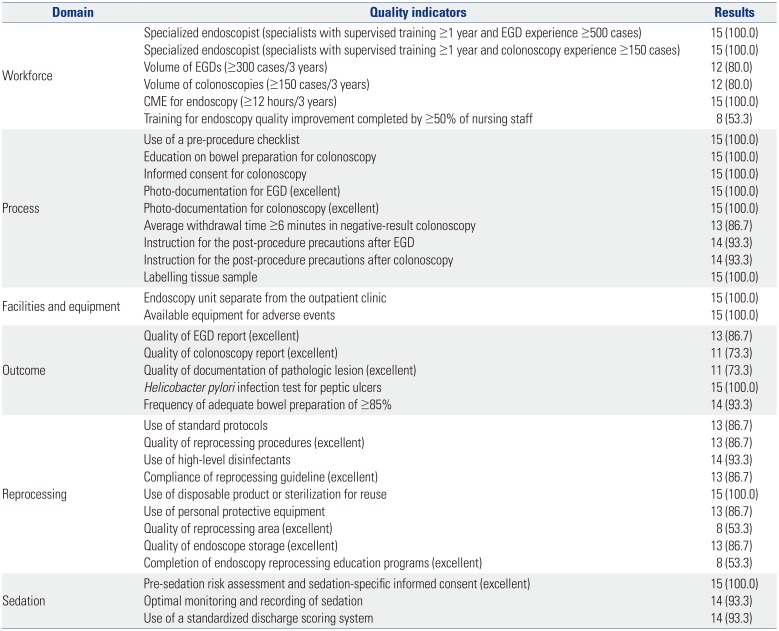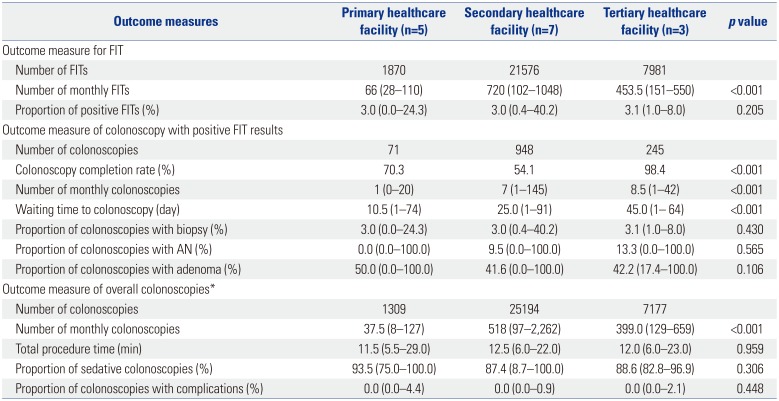1. Jun JK, Choi KS, Lee HY, Suh M, Park B, Song SH, et al. Effectiveness of the Korean National Cancer Screening Program in reducing gastric cancer mortality. Gastroenterology. 2017; 152:1319–1328. PMID:
28147224.

2. Choi KS, Jun JK, Park EC, Park S, Jung KW, Han MA, et al. Performance of different gastric cancer screening methods in Korea: a population-based study. PLoS One. 2012; 7:e50041. PMID:
23209638.

3. Lee S, Jun JK, Suh M, Park B, Noh DK, Jung KW, et al. Gastric cancer screening uptake trends in Korea: results for the National Cancer Screening Program from 2002 to 2011: a prospective cross-sectional study. Medicine (Baltimore). 2015; 94:e533. PMID:
25715251.
4. Shin A, Choi KS, Jun JK, Noh DK, Suh M, Jung KW, et al. Validity of fecal occult blood test in the National Cancer Screening Program, Korea. PLoS One. 2013; 8:e79292. PMID:
24260189.

5. Cha JM, Han DS, Lee HL, Kim YH, Chung IK, Kim HS, et al. Endoscopist specialty is associated with high-quality endoscopy in Korea. Yonsei Med J. 2012; 53:310–317. PMID:
22318818.

6. Cha JM, Moon JS, Chung IK, Kim JO, Im JP, Cho YK, et al. National Endoscopy Quality Improvement Program remains suboptimal in Korea. Gut Liver. 2016; 10:699–705. PMID:
27282270.

7. Cho YK. How to improve the quality of screening endoscopy in Korea: National Endoscopy Quality Improvement Program. Clin Endosc. 2016; 49:312–317. PMID:
27484810.

8. Park WG, Shaheen NJ, Cohen J, Pike IM, Adler DG, Inadomi JM, et al. Quality indicators for EGD. Am J Gastroenterol. 2015; 110:60–71. PMID:
25448872.

9. Rex DK, Schoenfeld PS, Cohen J, Pike IM, Adler DG, Fennerty MB, et al. Quality indicators for colonoscopy. Am J Gastroenterol. 2015; 110:72–90. PMID:
25448873.

10. Rembacken B, Hassan C, Riemann JF, Chilton A, Rutter M, Dumonceau JM, et al. Quality in screening colonoscopy: position statement of the European Society of Gastrointestinal Endoscopy (ESGE). Endoscopy. 2012; 44:957–968. PMID:
22987217.

11. Min JK, Cha JM, Cho YK, Kim JH, Yoon SM, Im JP, et al. Revision of quality indicators for the Endoscopy Quality Improvement Program of the National Cancer Screening Program in Korea. Clin Endosc. 2018; 51:239–252. PMID:
29874905.

12. Jover R, Herráiz M, Alarcón O, Brullet E, Bujanda L, Bustamante M, et al. Clinical practice guidelines: quality of colonoscopy in colorectal cancer screening. Endoscopy. 2012; 44:444–451. PMID:
22438159.

13. Harewood GC. Relationship of colonoscopy completion rates and endoscopist features. Dig Dis Sci. 2005; 50:47–51. PMID:
15712636.

14. ASGE Standards of Practice Committee. Jain R, Ikenberry SO, Anderson MA, Appalaneni V, Ben-Menachem T, Decker GA, et al. Minimum staffing requirements for the performance of GI endoscopy. Gastrointest Endosc. 2010; 72:469–470. PMID:
20579993.

15. American Society for Gastrointestinal Endoscopy. Quality improvement of gastrointestinal endoscopy: guidelines for clinical application. Gastrointest Endosc. 1999; 49:842–844. PMID:
10343248.
16. Bisschops R, Areia M, Coron E, Dobru D, Kaskas B, Kuvaev R, et al. Performance measures for upper gastrointestinal endoscopy: a European Society of Gastrointestinal Endoscopy (ESGE) Quality Improvement Initiative. Endoscopy. 2016; 48:843–864. PMID:
27548885.

17. Bretthauer M, Aabakken L, Dekker E, Kaminski MF, Rösch T, Hultcrantz R, et al. Requirements and standards facilitating quality improvement for reporting systems in gastrointestinal endoscopy: European Society of Gastrointestinal Endoscopy (ESGE) Position Statement. Endoscopy. 2016; 48:291–294. PMID:
26841269.

18. Kaminski MF, Thomas-Gibson S, Bugajski M, Bretthauer M, Rees CJ, Dekker E, et al. Performance measures for lower gastrointestinal endoscopy: a European Society of Gastrointestinal Endoscopy (ESGE) Quality Improvement Initiative. Endoscopy. 2017; 49:378–397. PMID:
28268235.

19. Reprocessing Guideline Task Force. Petersen BT, Cohen J, Hambrick RD 3rd, Buttar N, Greenwald DA, Buscaglia JM, et al. Multisociety guideline on reprocessing flexible GI endoscopes: 2016 update. Gastrointest Endosc. 2017; 85:282–294. PMID:
28069113.

20. Herrin A, Loyola M, Bocian S, Diskey A, Friis CM, Herron-Rice L, et al. Standards of infection prevention in reprocessing flexible gastrointestinal endoscopes. Gastroenterol Nurs. 2016; 39:404–418. PMID:
27684640.

21. Teh JL, Tan JR, Lau LJ, Saxena N, Salim A, Tay A, et al. Longer examination time improves detection of gastric cancer during diagnostic upper gastrointestinal endoscopy. Clin Gastroenterol Hepatol. 2015; 13:480–487. PMID:
25117772.

22. Park JM, Huo SM, Lee HH, Lee BI, Song HJ, Choi MG. Longer observation time increases proportion of neoplasms detected by esophagogastroduodenoscopy. Gastroenterology. 2017; 153:460–469. PMID:
28501581.

23. Kawamura T, Wada H, Sakiyama N, Ueda Y, Shirakawa A, Okada Y, et al. Examination time as a quality indicator of screening upper gastrointestinal endoscopy for asymptomatic examinees. Dig Endosc. 2017; 29:569–575. PMID:
28066945.

24. Januszewicz W, Wieszczy P, Bialek A, Karpinska K, Szlak J, Szymonik J, et al. Endoscopist biopsy rate as a quality indicator for outpatient gastroscopy: a multicenter cohort study with validation. Gastrointest Endosc. 2019; 89:1141–1149. PMID:
30659831.

25. Robertson DJ, Lee JK, Boland CR, Dominitz JA, Giardiello FM, Johnson DA, et al. Recommendations on fecal immunochemical testing to screen for colorectal neoplasia: a consensus statement by the US Multi-Society Task Force on Colorectal Cancer. Gastroenterology. 2017; 152:1217–1237. PMID:
27769517.

26. Kim DH, Cha JM, Kwak MS, Yoon JY, Cho YH, Jeon JW, et al. Quality metrics of a fecal immunochemical test-based colorectal cancer screening program in Korea. Gut Liver. 2018; 12:183–189. PMID:
29212310.

27. Meester RG, Zauber AG, Doubeni CA, Jensen CD, Quinn VP, Helfand M, et al. Consequences of increasing time to colonoscopy examination after positive result from fecal colorectal cancer screening test. Clin Gastroenterol Hepatol. 2016; 14:1445–1451. PMID:
27211498.
28. Gellad ZF, Almirall D, Provenzale D, Fisher DA. Time from positive screening fecal occult blood test to colonoscopy and risk of neoplasia. Dig Dis Sci. 2009; 54:2497–2502. PMID:
19093199.

29. Shin HY, Suh M, Baik HW, Choi KS, Park B, Jun JK, et al. Performance of the fecal immunochemical test for colorectal cancer screening using different stool-collection devices: preliminary results from a randomized controlled trial. Gut Liver. 2016; 10:925–931. PMID:
27282262.

30. Scholle SH, Roski J, Adams JL, Dunn DL, Kerr EA, Dugan DP, et al. Benchmarking physician performance: reliability of individual and composite measures. Am J Manag Care. 2008; 14:833–838. PMID:
19067500.







 PDF
PDF ePub
ePub Citation
Citation Print
Print



 XML Download
XML Download